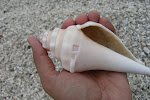The hike almost got cancelled because the day started out quite rainy and there was some worry about the hike being too muddy. I was glad that I was able to convince the group that we can go slowly and that getting dirty on the hike was part of the fun anyway.

 You have to go cut through some sword grass in the sabana to get to the islet.
You have to go cut through some sword grass in the sabana to get to the islet. Happy hikers: Rosita and Laurina
Happy hikers: Rosita and Laurina Then you go through a bit of secondary forest. It was pretty muddy and slippery. I thought for a second that maybe I shouldn't be so gung ho or determined the next time it's this rainy.
Then you go through a bit of secondary forest. It was pretty muddy and slippery. I thought for a second that maybe I shouldn't be so gung ho or determined the next time it's this rainy.The pretty and fragrant Sumac or Aidia cochinchinnsis


 Can you see the fringing reefs?
Can you see the fringing reefs? There she is!
There she is! There was enough walking sticks picked up on the trail between Laurina and Rosita for an entire cadre of hikers.
There was enough walking sticks picked up on the trail between Laurina and Rosita for an entire cadre of hikers.
 Looks quite treacherous!
Looks quite treacherous! Easy! Carefull!
Easy! Carefull! Plenty rocks, nei!
Plenty rocks, nei! Pretty sandstones in the dirt
Pretty sandstones in the dirt Our constant seashore companion: Princess Naupaka, the Half-flower.
Our constant seashore companion: Princess Naupaka, the Half-flower.  You can see two types of Screw Pines here: Pandanus tectorius in the foreground with the slimmer, longer leaves, and P. dubious in the background with the wider, shorter leaves. The Chamorros call these Kafu and Pahong respectively. There will be a quiz later.
You can see two types of Screw Pines here: Pandanus tectorius in the foreground with the slimmer, longer leaves, and P. dubious in the background with the wider, shorter leaves. The Chamorros call these Kafu and Pahong respectively. There will be a quiz later. Lantana camara or Wild sage. It is a pretty flowering shrub with an interesting odor.
Lantana camara or Wild sage. It is a pretty flowering shrub with an interesting odor. We found some Dodder or what the Hawaiians call Kauna'oa growing in the sabana or grassland
We found some Dodder or what the Hawaiians call Kauna'oa growing in the sabana or grassland Can you see the small white flowers of this parasitic plant?
Can you see the small white flowers of this parasitic plant? I blogged earlier about the Hawaiian island of Lanai's official lei made of orange Kauna'oa
I blogged earlier about the Hawaiian island of Lanai's official lei made of orange Kauna'oa I made DJ a quick mwarmwar with Kauna'oa and Lantana .
I made DJ a quick mwarmwar with Kauna'oa and Lantana .  We made it! Laurina, JP, DJ, Lino and Rosita.
We made it! Laurina, JP, DJ, Lino and Rosita. JP on location
JP on location Nice outcropping where you can see different layers of earth
Nice outcropping where you can see different layers of earth I see you!
I see you!






 C'mon, Rosita! I'll catch you if you fall!
C'mon, Rosita! I'll catch you if you fall! JP, the avid photographer
JP, the avid photographer

 An hour or two later, it was time to climb back out
An hour or two later, it was time to climb back outTanke Beach, Kagman
After Forbidden Island, I wanted to see Tanke Beach to maximize our time in Kagman. It gave DJ, Lauire and I the perfect opportunity to beachcomb a little for some neat critters. There are usually lots of marine debris on this beach since it faces the Pacific Ocean in the east. All sorts of trash washes up here from all over the Pacfic Rim.
A closer look after carefully taking out a few reveals some Isognomonidae, or Tree oysters. The beautiful inside is nacreous or pearly. The ancient Chamorros fashioned fish hooks out of these shells.
 Plenty trash, nei!
Plenty trash, nei!
A little hermit crab in a nice Fine-net Peristernia (Peristernia nassatula)

There are enough signs at Tanke Beach saying that it is a Marine Protected Area, yet we saw this guy obviously fishing there.

Ti napu.
The Beachcomber


 Chrissie, Devon and Lindsey at the top of the hike.
Chrissie, Devon and Lindsey at the top of the hike.



 The tide was very low even inside the hidden pool. We were actually able to stand on the bottom of the pool because it was so low! Luckily, the swimming area at the end of the beach was calm and deep enough for us to enjoy. We jumped in, cooled off, saw a few crabs and Abudefdufs (Sargeant major damselfish), and traded stories on stonefish.
The tide was very low even inside the hidden pool. We were actually able to stand on the bottom of the pool because it was so low! Luckily, the swimming area at the end of the beach was calm and deep enough for us to enjoy. We jumped in, cooled off, saw a few crabs and Abudefdufs (Sargeant major damselfish), and traded stories on stonefish.


